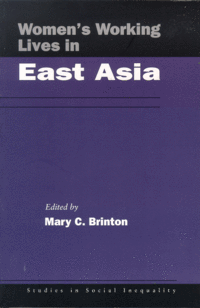

![]()
![]()

In all three countries there are hierarchical relations between men and women with a clear patriarchal bias. There are also similarities in terms of the high age at first marriage; timing and number of children; as well as the nuclear family being the most common form of household structure in all three countries. High educational attainment for both women and men means that many women delay entry to the job market until their early twenties.
Despite similar labour force patterns until the 1970s, Taiwan and South Korea subsequently developed significant differences: explored in the contribution by Brinton, Lee and Parish. They reveal that supply and demand, and government policies that have an impact on the demand for labour are intertwined with what are otherwise similar cultural contexts. For instance, while patriarchal values (common to both countries) may favour men and discourage women from entering the labour market, this value weakens when there is a high demand for labour that cannot be filled solely by the male gender.
The significance of government policy is further elaborated by Lu's contribution where the author illustrates that unlike Japan and South Korea, Taiwan's export-led economy primarily relies on the activities of small, family-led businesses where women have significant autonomy and bargaining power with their spouses where their husbands are the 'bosses' of the company. Although women are subordinate in decision-making, they nevertheless control key elements of factory production, finance, and the supervision of staff. Their contribution to the family business is such that they are often regarded as indispensable to the family business. Japan and South Korea have different stories to tell, however, since the governments of these countries have the policy of supporting export orientated enterprises with large loans so that family businesses tend to expand into large corporations - where women have no place. Since women are associated only with small businesses, this means that they lack power, responsibility and are denied the opportunity to develop the skills of their Taiwanese counterparts.
While some papers primarily concentrate on one East Asian country others compare two or more. Students of Japan will be rewarded with Ogasawara and Hirao's contributions, which both focus on Japan, while those interested in South Korea will turn to Lee's paper. Taiwan receives the most attention with three papers focusing primarily on this country, albeit with a comparative slant (Yu; Lu; Mehrotra and Parish). Only two papers take on the difficult task of comparing all three countries (Brinton; Lee and Hirata) while the remainder of the papers focus on two countries - namely, South Korea and Taiwan (Brinton, Lee and Parish), Japan and Taiwan (Yu) and, finally Japan and South Korea (Brinton and Lee).
This collection is a timely addition to studies of women and work in East Asia. While the voices of the women themselves could have been strengthened with the greater use of narrative and social context, the wealth of information packed into this volume makes it an ideal starting point for anyone interested in women and work in this region. For this reason alone, it is a pity that China was omitted given that it encompasses a great part of the region of East Asia. The authors, however, do make a case for the similarities and differences between Japan, Taiwan and South Korea that make them an interesting and rewarding focus for their analysis.
Fiona Harris
University of Aberdeen